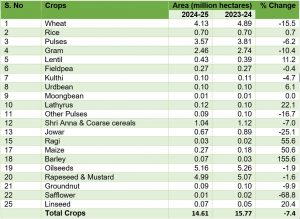The Ministry of Agriculture & Farmers Welfare has released preliminary data on Rabi crop sowing for the 2024-25 season, as of November 8, 2024. The data reveals mixed trends, with some crops experiencing a decline in sown area compared to the previous year, while others show modest increases.
Wheat Acreage Faces Notable Decline
Wheat, a staple rabi crop, has seen a significant drop in sowing area. This year, 4.13 million hectares (mln ha) have been covered, down from 4.89 mln ha during the same period last year—a decline of 0.76 mln ha. This reduction may have implications for overall wheat production in the upcoming season.
Rabi Rice and Maize Show Gains
In contrast, rabi rice sowing has increased slightly, with 0.704 mln ha reported compared to 0.699 mln ha last year, reflecting a marginal rise of 0.005 mln ha. Maize has also witnessed a significant uptick, with 0.271 mln ha sown this year, up from 0.18 mln ha last year.
Pulses and Coarse Cereals See Mixed Trends
The area sown for pulses has decreased to 3.57 mln ha, a drop of 0.24 mln ha from last year’s 3.81 mln ha. Among pulses:
- Gram: Sowing declined by 10.4%, with 46 mln ha covered compared to 2.74 mln ha last year.
- Lentil: Bucked the trend with an 11% increase, rising to 428 mln ha from 0.385 mln ha.
Coarse cereals, including Shri Anna, also recorded a decrease, with the total sown area dropping to 1.04 mln ha from 1.12 mln ha—a reduction of 0.08 mln ha.
Oilseeds Marginally Decline
The overall area under oilseeds has seen a slight reduction, with 5.16 mln ha sown compared to 5.26 mln ha last year. Rapeseed & Mustard, the dominant crop in this category, also recorded a marginal decline in acreage.
Preliminary Trends and Outlook for Rabi 2024-25
While the data reflects early trends, the government emphasizes that rabi sowing is still in its initial stages, and final figures are expected to align with normal sowing levels on comfortable soil moisture and good monsoon season. However, the preliminary trends indicate a mixed outlook:
- Declines in crops like wheat, gram, and coarse cereals could affect overall production.
- Increases in crops such as maize, lentil, and Rabi rice provide a silver lining.
